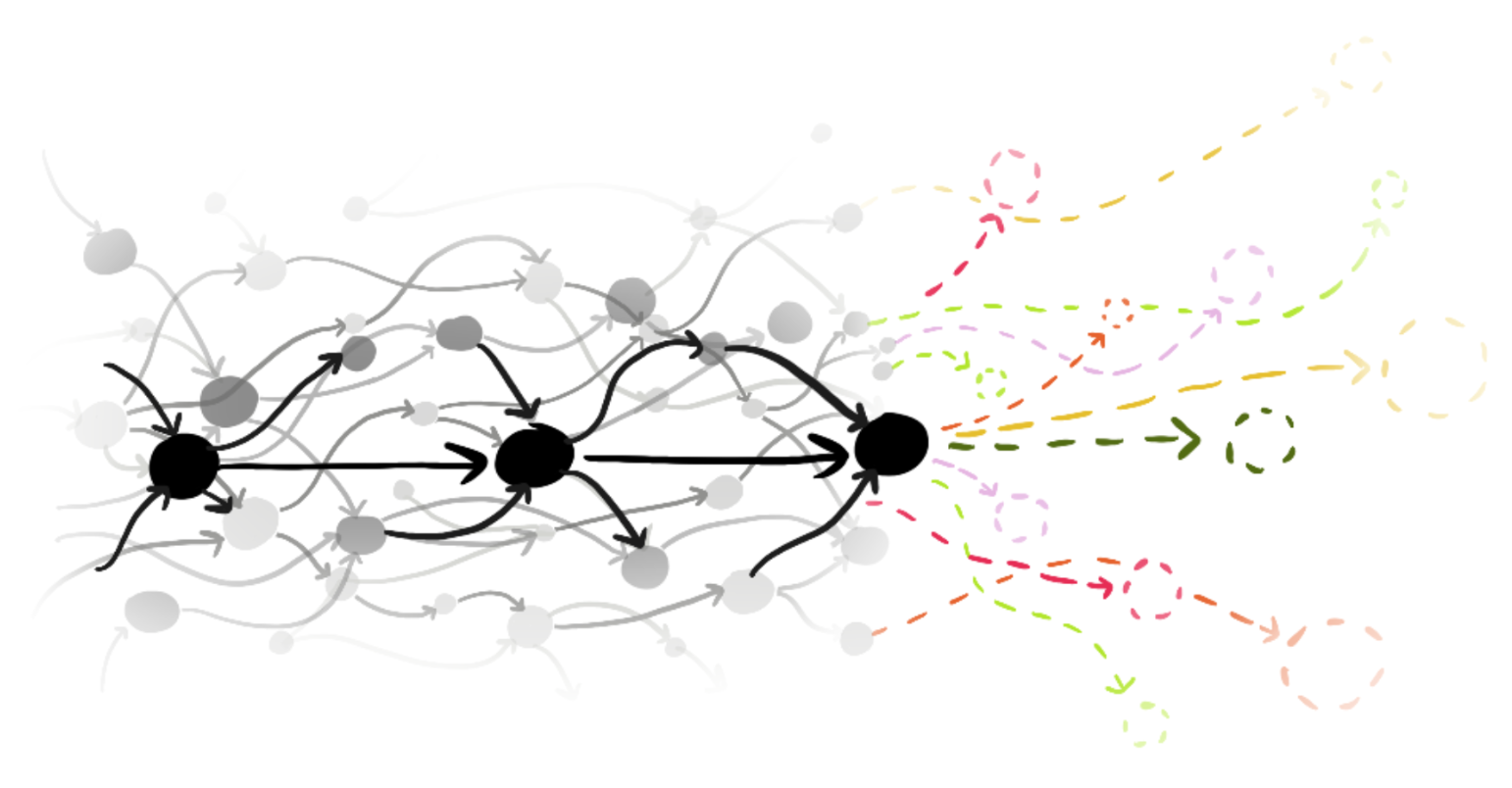Nobody Owns The Technofuture
Through this blog series, we are exploring what the world can look like when technology is designed and deployed for the benefit of all. These broad, near-future speculative pieces are designed to de-center dominant narratives and challenge us all to realize that things can be different. These are not alternative realities, they are possible futures.
Illustration by Sylvia Pericles.

We often talk about technology in terms of “progress”.

We see it everywhere. In games like the Civilization series, unlockable technological advances build on each other in a linear progression, building from bronze tools to education to mass production and industrialization. A lot of science fiction and popular media uses a particular set of technological tropes—think space travel, flying cars, humanoid robots—as shorthand for “the future” or an “advanced” civilization. Debates about life beyond Earth often belabor this question, too: do all life forms, given enough time and the right conditions, develop the same technologies humans have? Can we look for them in radio signals or spaceships that look or sound anything like ours?
We often talk about the future of technology in a way that’s different from how we talk about, say, the future of culture or politics. We know that it’s a very loaded thing to call a political change “progress” or to call one art form “more developed”. So why do we talk about technology like it’s headed towards some natural destination that science has predestined for us?
Take the future of transportation, for example. As gas consumption hastens environmental collapse, and driving errors kill countless people, technological advances like electric vehicles and self-driving cars feel like a natural next step. They feel like they’re solving concrete, immediate problems. They feel like the future.

And when we frame things that way, the conversations around the future of technology start to sound like: When will we drive electric cars? Which company will put out the first fully-autonomous vehicle? Which country is the most advanced in its self-driving car technology?
If your life is car-dependent, this framing makes a lot of sense. Many people have no choice but to drive: if your built environment has limited or inaccessible public transportation, sprawling above-ground parking lots that separate buildings, and unsafe biking and walking infrastructure, it can be prohibitively difficult to function without a car. So if you already need to drive to get to school, to work, to get groceries, to socialize—if this fact feels like an invisible reality of life— the idea that you could lessen your pollution or crash risk feels like an obvious improvement.
But erased from this narrative of “progress” are all of the problems that stem from car-centered urban planning itself. Better self-driving cars won’t prevent the mathematically-inevitable traffic and parking issues that stem from the sheer number of people moving into and out of dense urban areas. A vehicle being electric means nothing if you can’t afford a car or obtain a driver’s license to begin with.
When we frame self-driving cars and electric vehicles as the gleaming solution to the problems of pollution and vehicle deaths, we write out all of the other solutions to these problems: Dense housing. Multi-use roads. Robust public transportation.
In fact, Silicon valley-types have publicly speculated about how to solve urban transportation issues and accidentally re-invented public transportation so many times that it has become a running joke.
It’s when we lose sight of the histories and the infrastructure around us—when they feel inevitable and fixed— the potential paths forward can start to feel very narrow.
This is why it’s so important that we study, and highlight, the histories and the infrastructure around us. Because the trajectory of so-called technological progress is not a line. This is an imperialist, colonialist, hegemonic way of thinking about how we relate to technology.

The deeper you dig into understanding why technology is the way it is, the more you reveal a complex, messy, interconnected web of motives and circumstances and chance.

And in every piece of technology you see evidence of the particular circumstances of its creation.
Historian Dr. Mar Hicks describes this really well when they describe the origins of Facebook in Your Computer is On Fire. The first iteration of Facebook was called FaceMash, and it was a ‘hot or not’ rip-off site that pulled Zuckerberg’s women classmates’ photos from Harvard’s internal servers. Hicks points out that in this first iteration, Zuckerberg was just amplifying, speeding up, and scaling up the voyeurism and objectification people were already doing. They continue,
“Given this history, it may come as less of a surprise that his later platform designs had a kind of built-in voyeurism and a tendency to objectify and profit off of users, and that doing this without their full, knowing consent was baked into the nature and business model of the platform”
When we understand why Facebook is like that, it becomes a lot easier to see all of the other ways it could have been designed. And that is really important if we want to think about what’s possible for the future!
Because when we tell stories about our past that erase the histories of what could have been, and what almost happened, and why things happened the way that they did, it feels like the status quo is inevitable. It feels like anyone who’s rejecting the way things are right now is standing in the way of progress.
But that’s not true.
We can be having different conversations about the future of technology. Instead of Who’s going to invent the best self-driving car?, we need to start with: How do we get everyone where they need to go? How do we make sure people are living in safe and comfortable environments? How do we protect people who are already impacted by the climate catastrophe that we accelerated with gas-fueled cars? Only then will we get meaningful answers to the question: What role should technology play in helping us get there?
In Amsterdam, car infrastructure did begin to dominate the city in the 1970s. As Renate van der Zee writes in the Guardian, after a postwar Dutch economic boom made cars affordable for many more people, “urban policymakers came to view the car as the travel mode of the future.” Bicycling began to decrease substantially, and entire neighborhoods were destroyed to make way for automobile traffic.
With this increased pollution, neighborhood destruction, and thousands of car deaths—particularly of children—there grew sustained activism. Over the course of 40 years, organized activists succeeded in pushing forward legislation that prioritized the needs and safety of pedestrians and bicyclists over drivers.
This started from a place of refusal. One of the most famous campaigns against the car-centered changes centered the children that were now dying in vehicle accidents: Stop de Kindermoord (literally, “stop the child murder”).
And from there, activists had to sketch out, from awareness campaigns to legislative proposals, a vision for what their city could be instead. In a world that now includes affordable vehicles, how do we keep each other safe? How do we want to move through our cities?
Timnit Gebru put it well in her Wired op-ed Effective Altruism Is Pushing a Dangerous Brand of ‘AI Safety’:
"We can create a technological future that serves us instead. Take, for example, Te Hiku Media, which created language technology to revitalize te reo Māori, creating a data license ‘based on the Māori principle of kaitiakitanga, or guardianship’ so that any data taken from the Māori benefits them first. Contrast this approach with that of organizations like StabilityAI, which scrapes artists’ works without their consent or attribution while purporting to build ‘AI for the people.’ We need to liberate our imagination from the one we have been sold thus far: saving us from a hypothetical AGI apocalypse imagined by the privileged few, or the ever elusive techno-utopia promised to us by Silicon Valley elites."
As people committed to shaping a better future, technologically and otherwise, it’s our job to carry on the kind of slow, intentional, future-making tasks marginalized people have always had to do. It’s our job to ask the right questions, to expand our ideas of what is possible, and to challenge the dominant, techno-solutionist narratives.
We can start where abolitionist organizer Mariame Kaba puts us: “When something can’t be fixed, then the question is: What can we build instead?”
Do you have thoughts on techno-futures you’d like to see? Want to contribute? Let us know!